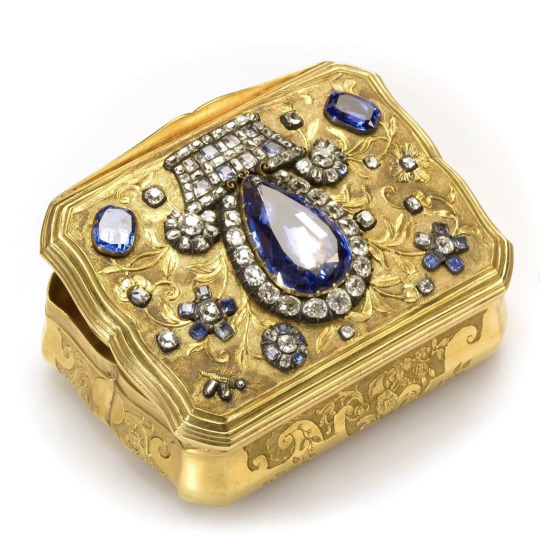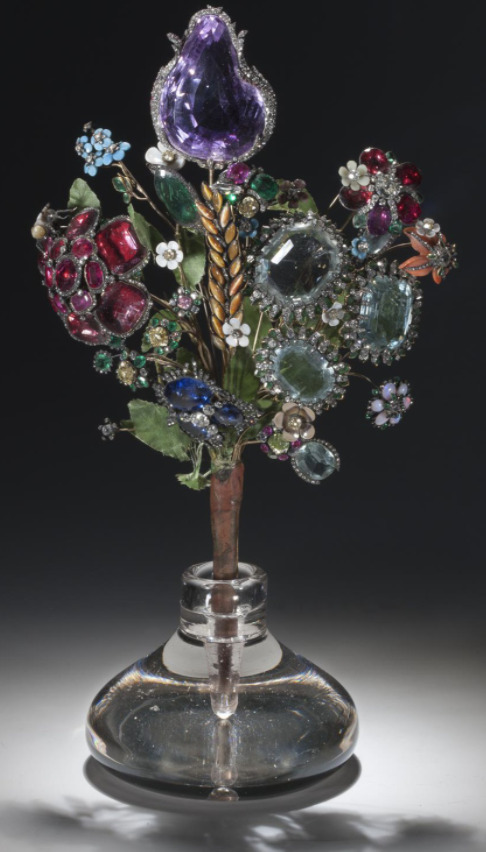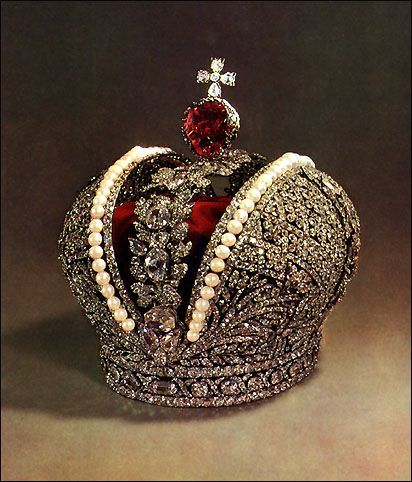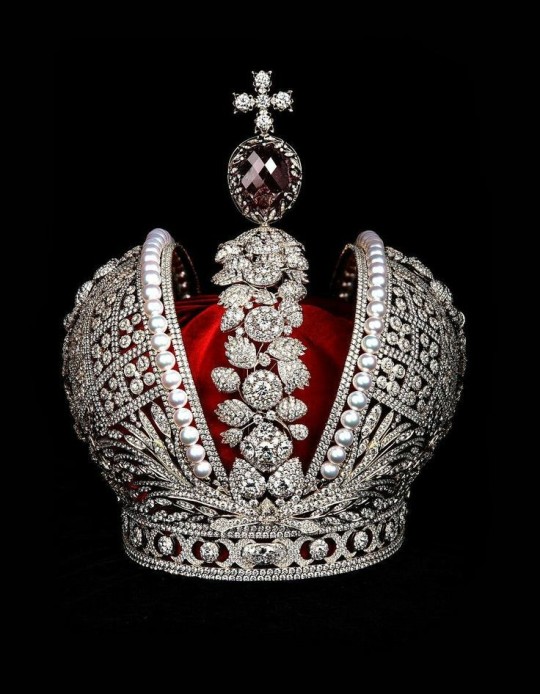#Jérémie Pauzié
Text

Imperial Crown of Russia or the Great Imperial Crown is one of the most outstanding examples of ‘regalia.’
Regalia is referred to as the emblems or insignia of royalty that survived through history.
It is a precious cultural heritage treasure — a well-documented and well-dated piece of jewellery.
Regalia jewellery pieces offer historians great insight into the gemstones used, their historical market values, and occurrences.
It also helps gemologists and jewellers to know how the gems were named and set on the piece of jewellery.
While royal crowns were usually made for individual rulers and later broken up, some of this royal regalia could be found in museums today.
Here are some interesting facts about one such royal artifact, the great Imperial Crown of Russia.
The Great Imperial Crown was made for Catherine the Great’s coronation, as the Russian Empress in 1762 AD, by Georg Friedrich Eckart and Jérémie Pauzié.
It is set with 4936 diamonds with a total weight of 2858 ct, 75 natural pearls, and a large 398.72 ct red spinel, historically known as “balas ruby,” which is among the largest ever reported in the literature, most probably from Badakhshan (today’s Tajikistan).
Imperial Crown of Russia was first worn by the Russian empress Catherine, followed by the subsequent seven emperors of her dynasty.
This royal regalia has remained a permanent fixture on the royal head.
This priceless artifact has been passed on to eight members of the Romanov family:
Catherine II, Peter III, Paul I, Alexander I, Nikolai I, Alexander II, Alexander III, and Nikolai II.
The Romanov dynasty survived till 1917, yet the crown publically appeared for the last time in 1906 at the opening ceremony of the first State Duma.
The crown was estimated to be worth $52 million in 1920.
The stones that the royal regalia comprises were sold off by the Bolsheviks and replaced in 1985.
Later in 1998, the crown was moved to the fund of Kremlin’s Diamond. Subsequently, it was declared to be priceless in a literal sense.
📷 : A modern replica version of the Imperial Crown was made in 2012 by Kristall-Smolensk, as part of the Jewellery project "Creation of Imperial Crown of Russia in Modern Interpretation" to celebrate the 400 years of the Romanov Dynasty and the 250 years of the Imperial Crown, as well as the 50th anniversary of the diamond industry in Russia.
Using white gold (original used silver) and 11,426 russian diamonds (original crown had 4,936 diamonds) from Alrosa with a total weight of 1180 ct, including 74 cultured pearls and a 384.71ct pear-shaped double rose cut purple tourmaline on top of the crown.
The spinel in the replica was replaced with a unique natural red tourmaline with a mass of about 400 karats.
#Imperial Crown of Russia#Great Imperial Crown#regalia#royalty#jewellery#gemstones#royal crowns#royal artifact#Catherine the Great#Georg Friedrich Eckart#Jérémie Pauzié#diamonds#pearls#red spinel#balas ruby#Catherine II#Peter III#Paul I#Alexander I#Nikolai I#Alexander II#Alexander III#Nikolai II#Romanov dynasty#Kristall-Smolensk#State Duma#Imperial Crown#diamond industry
6 notes
·
View notes
Text

Jérémie Pauzié gemstone-studded snuff box for Frederick the Great. Jérémie Pauzié, jeweler to the Tsars, was a Swiss whizz kid. Born in Geneva in 1716, his father dragged him across Europe on foot as a boy to make a life in Russia, and despite starting from scratch, by the time he was in his mid-20s, had his own jewelry workshop creating for the Imperial Court. Currently at the Hermitage. Source - Helen Molesworth on IG
78 notes
·
View notes
Text
Come on Ijekiel...still waiting for you to give Athy a bouquet made of gems...any day now...hand kiss aside, she'll fall for it...come on...

Like this made by Russian Imperial Jeweler Jérémie Pauzié.
#wmmap athykiel#athy x ijekiel#athykiel#athy#athanasia de alger obelia#wmmap athy#wmmap#who made me a princess#wmmap athanasia#who made me a princess athanasia#sibapod#suddenly became a princess one day#sbapod#suddenly i became a princess#sbapod athy#sibapod athy#isbapod#whomademeaprincess#i suddenly became a princess one day#suddenly became a princess#ijekiel alpheus#wmmap ijekiel#athanasia x ijekiel
30 notes
·
View notes
Text
Imperial Crown of Russia
I was crowned at the Assumption Cathedral in Moscow on September 22, 1762. The Imperial Crown of Russia was actually designed to my specifications by Swiss-French court diamond jeweller Jérémie Pauzié. Inspired by the Byzantine Empire design, the crown was constructed of two gold and silver half spheres, representing the eastern and western Roman empires, divided by a foliate garland and fastened with a low hoop. The crown contains 75 pearls and 4,936 Indian diamonds forming laurel and oak leaves, the symbols of power and strength, and is surmounted by a 398.62-carat ruby spinel that previously belonged to the Empress Elizabeth, and a diamond cross. The crown was produced in a record two months and weighed 2.3 kg. It was definitely a heavy crown to carry on my head...

1 note
·
View note
Text

The Imperial Crown was used by the monarchs of Russia from 1762 until the Russian monarchy's abolition in 1917. The Great Imperial Crown was first used in a coronation by Catherine the Great, and it was last worn at the coronation of Nicholas II. It was displayed prominently next to Nicholas II on a cushion at the State Opening of the Russian Duma inside the Winter Palace in St. Petersburg in 1906. It survived the 1917 revolution and is currently on display in Moscow at the Kremlin Armoury's State Diamond Fund.The court jeweller Ekart and Jérémie Pauzié made the Great Imperial Crown for the coronation of Catherine the Great in 1762. The beautiful crown reflects Pauzié's skilled workmanship. It is adorned with 4936 diamonds arranged in splendid patterns across the entire surface of the rown. Bordering the edges of the "mitre" are a number of fine, large white pearls. The crown is also decorated with one of the seven historic stones of the Russian Diamond Collection: a large precious red spinel weighing 398.72 carats (79.744 g), which was brought to Russia by Nicholas Spafary, the Russian envoy to China from 1675 to 1678. It is believed to be the second largest spinel in the world.
1 note
·
View note